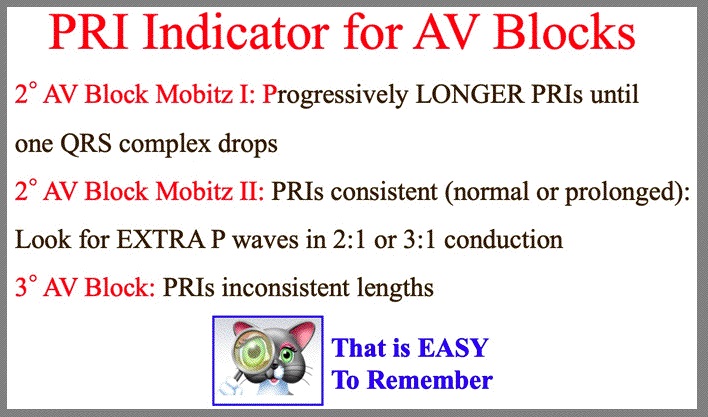| November 30 - December 4: Introducing the Significant Q wave, 2nd Degree AV Block Mobitz I, 2nd Degree Block Mobitz II and 3rd Degree AV Block OBJECTIVES: Be able to correctly know how to measure for a Significant Q wave Be able to correctly identify a 2nd degree AV block Mobitz I, a 2nd degree AV block Mobitz II, and a 3rd degree AV block, Be able to identify calculate a QTcorrected Class, Please download the EXAM FIRST. We are working through MOST Exam questions in the YOUTUBE video lectures. Click Here to Download Exam 4 Part D due Friday December 4 by 12 Midnight |
||||||||
| The PRI Indictor | ||||||||
 |
||||||||
 |
||||||||
| NOTE: There is NO underlying rhythm with the 2nd Degree AV Block Mobitz I | ||||||||
| 2nd Degree AV Block Mobitz II | ||||||||
| Class, please note below. The 2nd Degree AV Block Mobitz II very often develops a 2:1 conduction with 2 'P' waves for every QRS complex. Please see below; Interpretation: 2nd Degree AV Block Mobitz II: 2:1 Conduction (The arrows point out the 'P' waves) |
||||||||
 |
||||||||
Below is Another Common Configuration of the 2nd Degree AV Block Mobitz II 2nd Degree AV Block Mobitz II: 3:1 Conduction |
||||||||
 |
||||||||
| 3rd Degree AV Block | ||||||||
 |
||||||||
| The 3rd Degree AV Block is often referred to as a complete heart block because there is no communication or association of the atria and ventricles. Each has its own pacemaker working independently. Note how inconsistent the 'PRI' lengths are! With the 3rd Degree AV Block the PRIs lengths are inconsistent because the atria and ventricles are depolarizing independently. | ||||||||
| The PRI Indicator is the BEST way to Clearly Identify between the 2nd Degree (2 types) and the 3rd Degree AV Block. | ||||||||
 |
||||||||
| The Nonconducted PAC | ||||||||
 |
||||||||
| CLASS, YOU REPORT THE UNDERLYING RHYTHM, RATE, P WAVES, PRI and QRS TO THE LEFT(i.e., BEFORE) OF THE NONCONDUCTED PAC! AND WITH NONCONDUCTED PACS, STATE WHAT COMPLEX IT FOLLOWS--IN EKG ABOVE THE NONCONDUCTED PAC OCCURS AFTER THE 3rd COMPLEX. | ||||||||
| The QTcorrected (QTC) | ||||||||
| Class, we use Bazett's Formula for the Calculation of QTc. See more on Dr. Bazett below. | ||||||||
 |
||||||||
| Here is how you calculate the QTc | ||||||||
 |
||||||||
| Class, take your RR Square root to THREE decimal places as shown (.989). Then, calculate your QTc and take it to TWO decimal places. If the 3rd significant figure of the QTc is '5' or higher please round up as above (QTc= .53 sec). |
||||||||
| Exam 4 Part D: Click here to get questions: Exam is due by 12midnight on December 4. No late papers accepted. | ||||||||
|